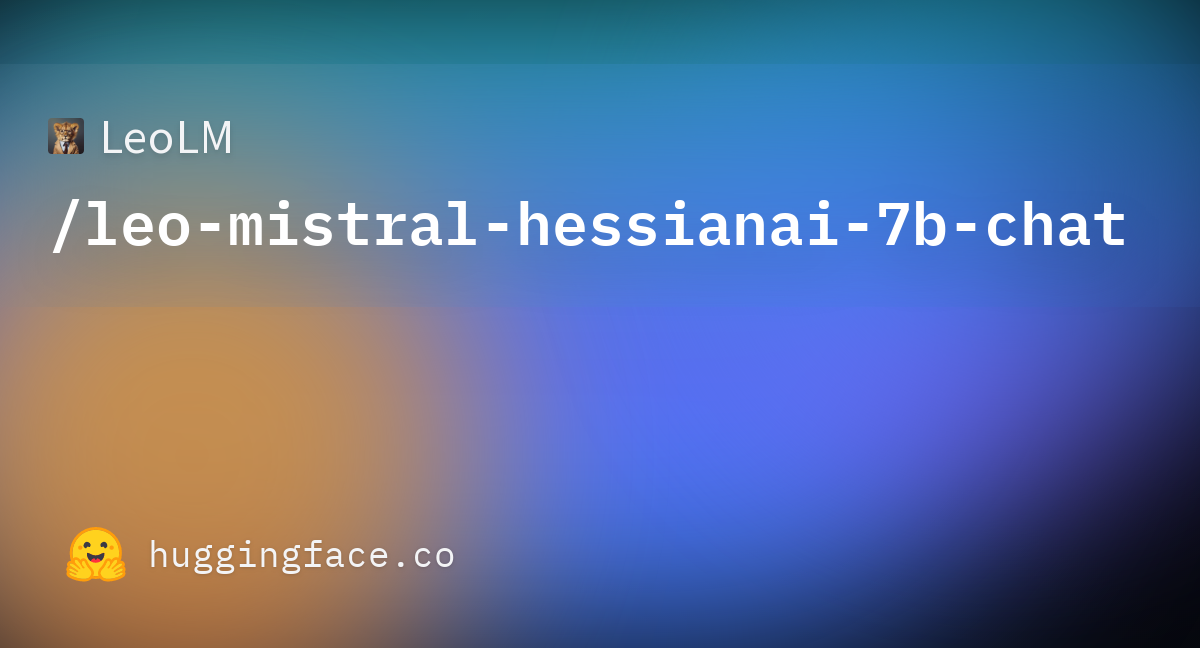
Our models extend Mistral’s capabilities into German through continued pretraining on a large corpus of German-language and mostly locality specific text.
Other fine-tuned models for foreign languages:
Was messing around with this a bit and it’s really quite good! It doesn’t work in text-generation-webui for some reason (probably end tokens but idk) and I had to use llama.cpp to interference, but it’s pretty good German! Sometimes, even with the correct prompt, it veers off course and starts doing something completely different though ._.
Mmh. Do we have any guess on how much non-english text is in Mistral-7b, the ‘foundation’-model? Obviously we can’t know exactly because they don’t release details.
But has anyone studied the models and tested the language capabilities and compared LLaMA to Llama 2 to Mistral-7b?
So, I’m a bit confused. I was looking for gguf files for that model to try it, but seems there aren’t any, yet.
But I found several other models called leo-hessianai. I believe they are based on Llama 2 and this one on Mistral. Did anyone compare them? Does anyone know other German models and which ones are good? Seems to be difficult to get any good information on that…
Quote from the newly released paper
Mistral 7B, we fine-tuned it on instruction datasets publicly available on the Hugging Face repository. No proprietary data or training tricks were utilized.
I have only seen Mistral models speaking German and French. If I had some free time (I don’t have rn) I could compare it to M2M100.
Hmm. I was waiting for something like SeamlessM4T to become available to me. I think that’d be most useful as a personal babelfish.
For conversation and storywriting I’d be okay with English and German. I don’t really speak any other languages well enough. But it has to work well. I’ve tried storywriting and chatting in German with some older models, but they were definitely not as smart or creative as if I was going to let something write a few paragraphs in english and then ask a multilingual model to translate it into vivid german words. I’m not sure to what extent fine-tuning it can rectify this.
Once I get a bit of time I can try it myself. I was just thinking since we’re talking about a german model here, someone would maybe have some experience on the subject.
(I also had some ordinary Llama model assist me in translating and it kinda worked to understand the comments I wanted to read. Even for some other languages than the big ones.)
I have less faith in llamacpp, new papers pop up every day, HF has more resource to keep up with everything.
Pytorch works well on CPU (without cuda), people would need a tutorial on how to set up venv (or smth better), use git clone, then assign the AutoModelForCausalLM to the downloaded model, then open a port on 5001. The code fits on the screen without having to scroll.
Any UI can connect to such a program. Character cards (from chub or other sources) are injected to the prompt from the frontend side. I used to download GGML files because they are lighter, and my download speed is from the past century.
Pytorch works well on CPU (without cuda), people would need a tutorial on how to set up venv
Thanks for the suggestion. Somehow I fail to reproduce your results. How do you do it? I’ve tried it with Oobabooga’s WebUI (for now):
I’ve tried AutoGPTQ. AutoGPTQ won’t like me to install it without CUDA. I got around that but now it says:
TypeError: mistral isn’t supported yet.(It also errors out with a different error message if I try Llama2.)
I’ve then switched to Transformers. With the GPTQ-version of the model it says:
RuntimeError: GPU is required to quantize or run quantize model.Then I deleted the quantized version and downloaded the whole thing. It takes 9 minutes with my internet speed.
- Loaded the model in 538.26 seconds.On inference:
UserWarning: The installed version of bitsandbytes was compiled without GPU support. 8-bit optimizers, 8-bit multiplication, and GPU quantization are unavailable.Loading it without quantization makes Oobabooga just sit there, pretend to do something but nothing happens. I somehow also doubt you’re getting performance out it this way. Doing inference on a CPU is memory-bound. And I seriously doubt it’s getting as fast now that I’m squeezing 15GB of data through the memory bus instead of like 4GB. So I’ve now stopped fiddling around with it.
Do you use it on CPU? If yes, do you use quantization? Which one? I’d like to try myself. But I don’t wan’t to try all the possibilities to find out which one works.
I have less faith in llamacpp, new papers pop up every day, HF has more resource to keep up with everything.
Disagree. Georgi Gerganov seems to be a crazy dude and on fire. So is the whole community behind the project. Regarding CPU inference and quantization, they were lightyears ahead of Huggingface, which just managed to get proper quantzation in recently. As far as I understand GPTQ isn’t as elaborate as the quantization ggml does. There is AWQ but that doesn’t seem to be a part of Transformers and the usual pipeline. It’s the same thing with all the other major advancements I’ve witnessed. I think llama.cpp had RoPE-Scaling first and several other things. They can do nice things like reuse the KV cache and avoid recalculating the whole context…
Something like StreamingLLM, the sliding window attention are worked on in both | projects.
For the last few months it used to be the way: once I read a potentially infuential paper, someone had already opened an issue at llama.cpp’s github page. It get’s on the roadmap and done eventually or you just wake up the next day and some crazy person had pulled an all-nighter and implemented all the maths for it.
Whereas progress with HF Transformers seemed slow. It either supported a specific use case or I had to spend several hours getting some fork with lots of custom code from the researchers’ github working.
And I remember fighting with GPTQ, the different branches for triton, cuda kernels and stuff, incompatible models and you needed to pull exactly the right commit or nothing would work.
With llama.cpp or KoboldCpp in my case, it’s just
git pull; make clean && make LLAMA_OPENBLAS=1 LLAMA_CLBLAST=1and you go. No gigabytes of pytorch and python modules with platform specific and sometimes incompatible binaries/wheels attached. But you’re right. If you’re only using HF Transformers for one of its well supported use cases, without a complex project around it and using the same hardware as everone else does, it’s easy. And you’re right. I’ve written a small wrapper and the code to use the AutoSomethingForSomething and do inference fits in a few lines. But so does the example C code for llama.cpp.Do they (HF) really implement things like QA-LoRA or newer stuff we’ve talked about 2 weeks ago quickly? I’m not sure. To me it seems more like implementations come from externally and things get included at some point, once enough people use/request it. They aren’t really using their resources to ‘keep up’ in my observation. More following what happens. But they do great things, too. I don’t want to badmouth them. We wouldn’t be where we are, without HF and Transformers in specific. It was there years before GGML was a thing, and all the researchers and projects build upon Transformers. And once you do more than just simple inference, you’re probably going to use it.
But having some example code along with a new paper only gets you so far. Once you want to incorporate those new advancements into some of your projects and really use it, it get’s difficult. All the custom additions and the old forked and customized dependecies that the researchers did when they started working on it, makes it difficult to do anything with it without dissecting the whole thing.
TL;DR You’re right, pytorch and transformers need more memory.
I will respond to the CPU inference first, for the transformers library.
Do you use it on CPU? If yes, do you use quantization? Which one? I’d like to try myself. But I don’t wan’t to try all the possibilities to find out which one works.
In transformers, I don’t use quant. :L If you’re used to the Q_4 speed, then it will be slower than that. For a 7B it’s almost okay on CPU.
And I seriously doubt it’s getting as fast now that I’m squeezing 15GB of data through the memory bus instead of like 4GB.
Yeah, it seems like you use low quant downloads. D: It’s not for you.
But you were on the right track with that 15GB download because you downloaded the raw release. Since not the GPTQ, nor AWS what we use in transformers (for new releases). ^^
With llama.cpp or KoboldCpp in my case, it’s just git pull; make clean make LLAMA_OPENBLAS=1 LLAMA_CLBLAST=1 and you go.
That’s why I prefer c/rust code, it just works. It will always be faster whatever HF will release, with or without quant.
Regarding CPU inference and quantization, they are ahead…
Right, C/Rust code is more optimized.
If you’re only using HF Transformers for one of its well supported use cases, without a complex project around it and using the same hardware as everone else does, it’s easy.
Pytorch w/o Nvidia card is less common >:D That’s how I started.
Imho most github sources release buggy code, they do not set device(‘cpu’) for cpu users. Avoiding dependency hell is a must. I prefer a commented single file, not a complex python project that spits out “bitsandbytes” errors.
They can do nice things like reuse the KV cache and avoid recalculating the whole context…
So as HF, in their cough code cough. It is likely that the same code in C is also more readable.
The reason I mentioned transformers because this line takes care of new model releases with all the bugfixes, just as ***cpp projects do.
generator= pipeline('text-generation', model='NousResearch/Nous-Capybara-7B') generator('Here is the prompt.')We run out of context?! Fix that. Use rotary embedding.
model = AutoModelForCausalLM.from_pretrained( "NousResearch/Nous-Capybara-7B", rope_scaling={"type": "dynamic", "factor": 2.0}, ) generator= pipeline('text-generation', model=model) generator('Here is the prompt.')Does it eat all your RAM? It does. It just works ™ with fineprint.
How to train with tools? Download another tool! With transformers:
model = AutoModelForCausalLM.from_pretrained( "NousResearch/Nous-Capybara-7B", use_flash_attention_2=True, ) trainer = SFTTrainer( model, train_dataset=dataset, dataset_text_field="text", max_seq_length=512, # context size is 512 ) trainer.train()Does it eat all you RAM? Yup, it goes beyond 64GB.
peft_config = LoraConfig(r=16, task_type="CAUSAL_LM") trainer = SFTTrainer( model, train_dataset=dataset, dataset_text_field="text", peft_config=peft_config )Now it eats less RAM with Lora.



